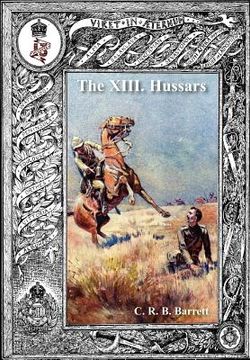Reseña del libro "History of the XIII Hussars Volume 2 (en Inglés)"
British light dragoons were first raised in the 18th century. Initially they formed part of a cavalry regiment performing scouting, reconnaissance and the like, but due to their successes in this role (and also in charging and harassing the enemy), they soon acquired a reputation for courage and skill. Whole regiments dedicated to this role were soon raised; the 15th Light Dragoons were the first, followed by the 18th Light Dragoons and the 19th Light Dragoons.The 13th Light Dragoons were initially heavy dragoons known as Richard Munden's Regiment of Dragoons. By 1751 the regiment title was simplified to the 13th Regiment of Dragoons and by 1783 they had been converted to the light role. In 1861 the regiment changed its name to the 13th Hussars.The 13th light Dragoons served around the world including in the Peninsular War, at Waterloo, in India and in the Crimean War.The Peninsular WarAt Campo Mayor on the Spanish-Portuguese border (25 March 1811) a clash occurred between British and Portuguese cavalry, under Robert Ballard Long, and a force of French infantry and cavalry under General Latour-Maubourg. This was to be one of the 13th Light Dragoons most famous and infamous actions. The 13th, two and a half squadrons strong, led by Colonel Michael Head, charged and routed a superior French cavalry force of no less than six squadrons. The 13th, with two Portuguese squadrons, then went on to pursue the French for seven miles to the outskirts of Badajoz. The report reaching Lord Wellington seems to have glossed over the epic quality of the charge and emphasised the overlong pursuit. After receiving Marshal Beresford's report, Wellington issued a particularly harsh reprimand to the 13th LD calling them "a rabble" and threatening to remove their horses from them and send the regiment to do duty at Lisbon. The officers of the regiment then wrote a collective letter to Wellington detailing the particulars of the action. Wellington is reported as saying that had he known the full facts he would never have issued the reprimand.[1] The historian Sir John Fortescue wrote, "Of the performance of Thirteenth, who did not exceed two hundred men, in defeating twice or thrice their numbers single-handed, it is difficult to speak too highly."[2]On the 16 May 1811, the 13th Light Dragoons formed part of Beresford's Allied-Spanish Army at Albuera during the Peninsular War. The French army, commanded by Marshal Jean-de-Dieu Soult, Duc de Dalmatie, was attempting to relieve the French garrison of the border fortress of Badajoz. Only after bloody and fierce fighting, and the steadfastness of the British infantry, did the allies carry the day. The 13th Light Dragoons, who were unbrigaded, along with the 3rd Dragoon Guards and the 4th Dragoons under Brigadier George Grey, plus a brigade of Portuguese dragoons, formed the cavalry force commanded by, initially, Brigadier Robert Ballard Long, and later in the battle by Major General Sir William Lumley. The 13th numbered 403 in four squadrons equipped with Paget light cavalry carbine and 1796 pattern sabre.On the 21 June 1813, the regiment saw action at the Battle of Vittoria; the last major battle against Napoleon's forces in Spain opening the way for the British forces to invade France. The Allied army under the command of Lieutenant General Arthur Wellesley, Marquess of Wellington decisively defeated the French army under Joseph Bonaparte, King of Spain and brother of the Emperor Napoleon Bonaparte. Along with the 10th Light Dragoons and 15th Light Dragoons, the 13th Light Dragoons formed the 2nd Brigade (part of the right centre column), commanded by Colonel Colquohon Grant.Light dragoons before 1812 wore a dark blue, braided, dolman jacket and a leather Tarleton helmet with a bearskin crest. After the uniform changes of 1812, often not fully implemented until 1813, light dragoons wore dark blue jackets with short tails and a bell-topped shako. Wellington criticised the new uniform as being too sim

